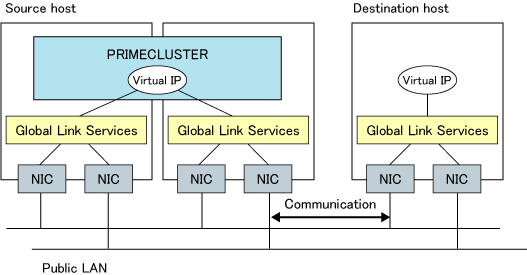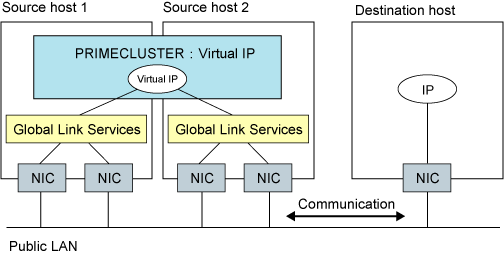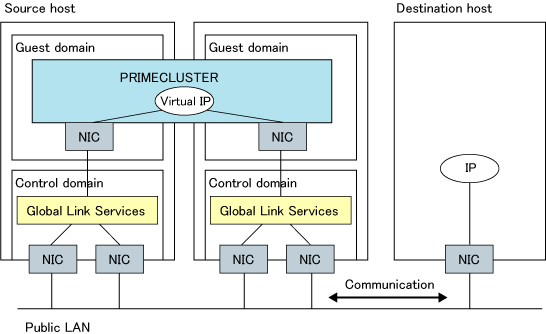GLS is a software product that enables high reliability communications through the use of multiple network interface cards (NICs) to create redundant multiple transfer routes to a local system. Global Link Services provides network solutions that are suitable for systems in which communications continuity is important.
The benefits of Global Link Services are as follows:
Multiple NICs can provide redundant transfer routes to offer high availability and path failure protection.
The use of GLS means that applications can continue to run even in the event of changes in the LAN configuration, the redundant transfer route, or any network fault that may occur in a transfer route.
GLS provides the following two functions:
Redundant Line Control Function
Fast switching mode
Multiplexing transfer routes between servers on the same network.
NIC switching mode
Configuring redundant transfer routes between servers and switches/HUBs on the same network.
Virtual NIC mode (Solaris)
Configuring redundant transfer routes between servers and switches/HUBs on the same network. By using the redundant route in the virtualization environment (guest domain or non-global zone), the virtual server is effectively aggregated.
Virtual NIC mode (Linux)
Configuring redundant transfer routes between servers and switches/HUBs on the same network. By using the redundant route in the virtualization environment (guest OS of the virtual machine function), the virtual server is effectively aggregated.
GS/SURE linkage mode (Solaris) and GS linkage mode (Linux)
Multiplexing transfer routes among the server on the same network, global server/SURE SYSTEM, and ExINCA.
Multipath mode (Solaris)
Multiplexing transfer routes between servers and switches on the same network.
Multilink ethernet mode (Solaris)
Distributing transfer data load on the multiplexed transfer route between servers and switches on the same network.
See
For details on the functions of Global Link Services, see "PRIMECLUSTER Global Link Services Configuration and Administration Guide: Redundant Line Control Function," "PRIMECLUSTER Global Link Services Configuration and Administration Guide: Redundant Line Control Function for Virtual NIC Mode," and "PRIMECLUSTER Global Link Services Configuration and Administration Guide: Multipath Function." The manual of virtual NIC mode and the manual of the multipath function are for Solaris only.
A redundant transmission route between Solaris servers or Linux servers in the same network is used so that the total amount of data transferred can be increased, and that the data communication can be continued even if the transmission route fails.
It also enables higher levels of throughput through redundant transmission routes. GLS performs early failure detection, so when one transmission route fails, the failed route will be cut off then the system will be operated on a reduced scale. The compatible hosts are SPARC Servers, PRIMEPOWER, GP7000F, Fujitsu S series, GP-S, PRIMERGY, and PRIMEQUEST.
Note that fast switching mode cannot be used to communicate with hosts on the other networks beyond the router.
Figure 2.13 Fast switching mode

Redundant NICs (LAN cards) are connected to each other on the same network and used exclusively to control the switch of transmission route. There are no restrictions on remote systems to communicate with via router.
Figure 2.14 NIC switching mode

Virtual NIC mode (Solaris) enables communication with multiple physical NICs (LAN cards) that are connected on the same network, in order to show a single logical generating virtual interface. There are no restrictions on the devices that can be connected, and it is possible to communicate with hosts on other networks via the router. For Oracle VM environment, using the virtual interface created on the control domain can be used to communicate with the guest domain.
Figure 2.15 Virtual NIC mode (Solaris)

Virtual NIC mode (Linux) enables communication with multiple physical NICs (LAN cards) that are connected on the same network, in order to show a single logical generating virtual interface. In this mode, switching of transfer route is controlled using redundant NIC. There are no restrictions on the devices that can be connected, and it is possible to communicate with hosts on other networks via the router.
Figure 2.16 Virtual NIC mode (Linux)

Enables the system to control transfer route by using a Fujitsu method for high-reliability communication between the system and Global Server. In this mode, redundant lines are used simultaneously. During normal operation, transfer routes are automatically assigned to each TCP connection for communication. In the event of an error, the system disconnects the faulty transfer route and operates on a reduced scale by moving the TCP connection to the normal transfer route.
Figure 2.17 GS/SURE linkage mode (Solaris), GS linkage mode (Linux)
